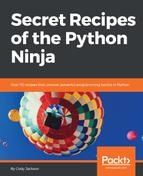In this chapter, we will cover Python's math module and the various mathematical functions provided in it. We will also talk about math-related modules, including cryptography and statistics. Specifically, we will discuss the following topics:
- Using the math module's functions and constants
- Working with complex numbers
- Improving decimal numbers
- Increasing accuracy with fractions
- Working with random numbers
- Using the secrets module
- Implementing basic statistics
- Improving functionality with comath
Python uses a hierarchy of abstract base classes to represent number-like classes. While the types defined by the abstract classes cannot be instantiated, they are used to create a numbers tower of subclasses: number -> complex -> real -> rational -> integral.
The reason for this is to allow functions that accept numbers as arguments to determine the properties of the arguments, thus allowing for backend functionality to be applied without user intervention. For example, slicing requires arguments to be integrals, whereas math module functions require real numbers as arguments. By ensuring these number classes are used, Python can provide for inherent functionality, for example, arithmetic operations, concatenation, and so on, as determined by the types used.
